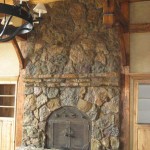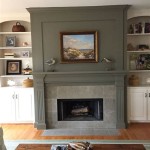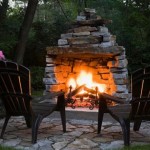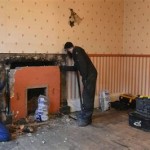Best Gas Fireplace Logs: Vent-Free Options
Vent-free gas fireplace logs offer a convenient and efficient alternative to traditional wood-burning fireplaces. They provide the ambiance and aesthetic appeal of a fire without the need for a chimney or venting system. Choosing the best vent-free gas fireplace logs involves considering various factors, including heating capacity, realism, safety features, and overall design.
This article examines key aspects of vent-free gas fireplace logs, providing information to assist in making an informed purchasing decision. Understanding the technology, regulations, and available options ensures that the selected vent-free logs meet individual needs and preferences.
Understanding Vent-Free Gas Fireplace Log Technology
Vent-free gas fireplace logs operate by burning natural gas or propane with a high degree of efficiency. Combustion occurs within a controlled environment, minimizing the production of carbon monoxide and other harmful emissions. These logs are designed to operate without a chimney or vent, relying on room air for combustion and releasing the resulting heat directly into the space. This contrasts with vented gas fireplaces, which exhaust combustion byproducts through a flue.
The key to safe and efficient operation lies in the Oxygen Depletion Sensor (ODS). This safety device constantly monitors the oxygen level in the room. If the oxygen level drops below a predetermined threshold, indicating a potential buildup of carbon monoxide, the ODS automatically shuts off the gas supply, preventing further combustion. This feature is a critical safety component in all certified vent-free gas fireplace logs.
Vent-free gas fireplace logs are available in various sizes and BTU (British Thermal Unit) ratings. BTU is a measure of heat output, with higher BTU ratings corresponding to greater heating capacity. Selecting the appropriate BTU rating is crucial for effectively heating the intended space without overheating. Overheating can lead to discomfort and potentially trigger the ODS, causing the unit to shut down prematurely.
The realism of the flame and log appearance has also improved significantly. Modern vent-free log sets often utilize intricate molding and painting techniques to mimic the look of natural wood. Some sets even include ember beds that glow and flicker, further enhancing the visual appeal. The burner system is designed to create a realistic flame pattern, contributing to the overall ambiance.
However, vent-free appliances should not be used in tightly sealed rooms or in rooms with poor ventilation. Proper airflow is essential for ensuring adequate oxygen levels and preventing the accumulation of combustion byproducts. It is necessary to ensure that the room meets the minimum size requirements specified by the manufacturer.
Key Considerations When Selecting Vent-Free Gas Fireplace Logs
Several factors influence the suitability of vent-free gas fireplace logs for a particular application. These considerations encompass safety, aesthetics, functionality, and regulatory compliance.
Safety Certification and Compliance: All vent-free gas fireplace logs should be certified by a recognized testing laboratory, such as the Canadian Standards Association (CSA) or Underwriters Laboratories (UL). Certification ensures that the logs have been tested and meet established safety standards for combustion efficiency, emissions, and overall performance. Local building codes and regulations may also impose additional requirements for the installation and use of vent-free appliances. Compliance with these regulations is essential for safe and legal operation.
BTU Rating and Heating Capacity: Determining the appropriate BTU rating is critical for effectively heating the intended space. A general guideline is to use 30-40 BTU per square foot in a well-insulated room. However, factors such as ceiling height, window area, and insulation levels can influence the actual heating requirements. Consulting a qualified professional can assist in determining the optimal BTU rating for a specific application.
Log Material and Appearance: Vent-free gas fireplace logs are typically made from ceramic fiber or refractory cement. Ceramic fiber logs are lightweight and heat up quickly, while refractory cement logs are more durable and retain heat longer. The appearance of the logs is a matter of personal preference, with options ranging from traditional oak and birch to more contemporary designs. Consider the overall aesthetic of the room and choose logs that complement the existing décor.
Ignition System: Vent-free gas fireplace logs are available with various ignition systems, including manual, electronic, and remote-controlled options. Manual ignition requires the user to light the pilot light manually, typically with a match or lighter. Electronic ignition uses an electronic spark to ignite the pilot light. Remote-controlled ignition allows the user to turn the fireplace on and off and adjust the flame height from a distance. The choice of ignition system depends on individual preferences and convenience requirements.
Oxygen Depletion Sensor (ODS): As previously mentioned, the ODS is a critical safety feature that monitors the oxygen level in the room. Ensure that any vent-free gas fireplace logs purchased are equipped with a properly functioning ODS. Regular inspection and maintenance of the ODS are essential for ensuring continued safe operation.
Room Size and Ventilation: Vent-free gas fireplace logs require adequate room size and ventilation for safe and efficient operation. Most manufacturers specify minimum room size requirements in their product documentation. Ensure that the room meets these requirements before installing vent-free logs. Adequate ventilation is also essential for maintaining proper oxygen levels and preventing the accumulation of combustion byproducts. Avoid using vent-free logs in tightly sealed rooms or rooms with poor ventilation.
Installation and Maintenance of Vent-Free Gas Fireplace Logs
Proper installation and regular maintenance are crucial for ensuring the safe and efficient operation of vent-free gas fireplace logs. Following the manufacturer's instructions and guidelines is essential for avoiding potential hazards and maximizing the lifespan of the appliance.
Professional Installation: It is advisable to have vent-free gas fireplace logs installed by a qualified professional. A professional installer can ensure that the logs are properly connected to the gas supply, that the ODS is functioning correctly, and that the fireplace meets all applicable safety codes and regulations. Improper installation can lead to gas leaks, carbon monoxide poisoning, or other hazards.
Gas Line Connection: Vent-free gas fireplace logs require a connection to a natural gas or propane supply line. Ensure that the gas line is properly sized and installed according to local codes and regulations. A qualified plumber or gas fitter should perform the gas line connection to ensure that it is leak-free and safe.
Log Placement: The placement of the logs within the firebox is crucial for proper combustion and flame appearance. Follow the manufacturer's instructions carefully when arranging the logs. Avoid blocking the burner ports or the ODS sensor. Incorrect log placement can lead to incomplete combustion, excessive carbon monoxide production, or premature shutdown of the fireplace.
Regular Cleaning and Inspection: Regular cleaning and inspection of vent-free gas fireplace logs are essential for maintaining their performance and safety. Dust and debris can accumulate on the logs and burner, affecting combustion efficiency and flame appearance. Clean the logs and burner regularly with a soft brush or vacuum cleaner. Inspect the gas connections and ODS sensor periodically for any signs of damage or malfunction. If any problems are detected, contact a qualified professional for repair.
Carbon Monoxide Detector: Install a carbon monoxide detector in the room where the vent-free gas fireplace logs are located. A carbon monoxide detector will provide an early warning in the event of a carbon monoxide leak. Test the carbon monoxide detector regularly to ensure that it is functioning properly. Replace the batteries in the carbon monoxide detector at least once a year.
Annual Servicing: Schedule an annual servicing of your vent-free gas fireplace logs by a qualified professional. A professional servicing will include a thorough inspection of all components, cleaning of the burner and logs, and testing of the ODS sensor. Annual servicing will help to ensure that your vent-free gas fireplace logs are operating safely and efficiently.
By understanding the technology behind vent-free gas fireplace logs, considering key selection factors, and adhering to proper installation and maintenance procedures, users can safely and effectively enjoy the warmth and ambiance of a gas fireplace without the need for a chimney or vent. Careful consideration and adherence to safety guidelines are paramount when utilizing vent-free heating appliances.

Napoleon Gvfl30 Ventless Gas Log Set 30 Inch

The Best Gas Log Sets For 2024 Fireplaces Direct Learning Center

Top 6 Ventless Gas Log Sets Woodlanddirect Com

Best Gas Log Sets With Remotes Fireplaces Direct Learning Center

Duluth Forge 22 In W Vent Free Natural Gas Fireplace Log Set Winter Oak 32 000 Btu Thermostat Control Dls N22t The Home Depot
:max_bytes(150000):strip_icc()/ventless-gas-fireplaces-4160746-hero-f9d4bdcd9bd446eb84406de306f790ba.jpg?strip=all)
How To Pick Out A Ventless Gas Fireplace

Best Gas Log Sets With Remotes Fireplaces Direct Learning Center

Vent Free Unvented Gas Logs Greenville Sc Blue Sky Chimney

White Mountain Hearth Lsxxp Kit Refractory Ponderosa Complete Fireplace Log Set

The Best Gas Log Sets For 2024 Fireplaces Direct Learning Center
Related Posts








